09.01.
– 11.02.2004: Staying with Friends in Bolivia (Torsten)
translated
by Renate
Adam
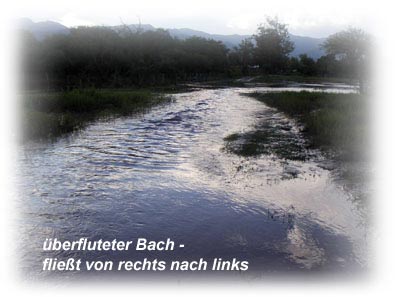
Once more we enter Bolivia. The first “challenge” is already waiting for us at the border: Leaving Argentine the exit formalities at the border in Pocitos are a torture, and that only because the Argentine officials here are arrogant and corrupt. The heat is unbearable and it takes us more than two hours to hand back the paper that has been our temporary Argentine driving licence. (Finally I outwitted the guys at the customs as nobody really seemed to be responsible. They sent us from one of the guys to the next, so I at last made the incredibly important paper disappear in the pocket of my trousers and went away!)
Fortunately entering Bolivia is again no problem and does not take more than a quarter of an hour. We overcome our second “challenge” 13 km after having left Yacuiba, in the small place Campo Pajoso, where military sentries stop us. Because of the ever lasting formalities at the Argentine border and for other reasons, we have already been travelling for 9 hours. So I feel little enthusiastic about another check of our papers and ask if it really has to be done. One of the military policemen snaps rather sharply, “Now you will get a complete control, papers and luggage!” I reply, that we only want to go and see our friend Herbert here in Campo Pajoso – “Nada más” (nothing else).
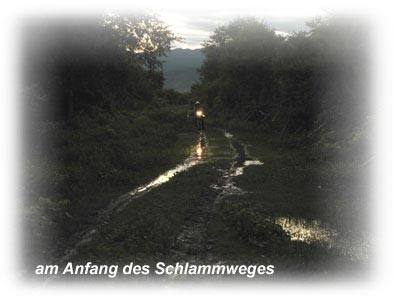
He has only heard the name ‘Herbert’. “What did you say?” he is now singing small, “You are going to ‘Don Herbert’?” ”Yes, we are. We are relatives.” I exaggerate awfully to make him feel more insecure than he already does. “Why didn’t you say that at the beginning? Do you know the way? You have to take a right turn here and then go on for 3 km. Everything okay – have a nice trip.” He hurries towards the turnpike and opens it for us he himself. “Well”, I think, “Don Herbert seems to be a person of influence here.”
So we take a right turn onto
a gravel road, after 300 m we face a country
road in a very bad state. And this ends after 200 m at our third
“challenge”: a flooded rivulet.
So that’s it, we have to face the fourth “challenge”:
It is too much for Ricarda; “I knew from the beginning that just
before reaching the destination we would have to go through
such a silly stream again. I won’t go through.
Shit…” etc.
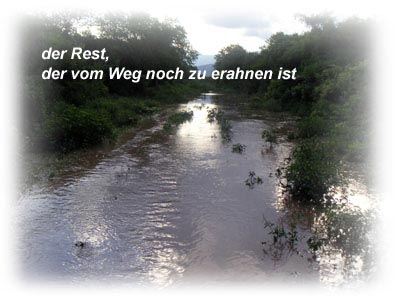
As there is no choice we have to pass. After a short while we face the fifth “challenge” which is the gate in the fence of Herbert’s finca, which is closed by chain and lock. Fortunately a man on horseback arrives at this moment, who intends to leave the finca. He opens the gate and tells us that ‘Don Herbert’ is not at home. Nevertheless he lets us pass advising us urgently to take the road to the left, taking the right hand road we would have to pass another rivulet. Well then, we take a left turn – only to face the sixth “challenge”: the road can only be passed for about 300 metres and then it seems nearly impossible to go on. That what seems to be the road is either flooded or slushy, muddy, dirty. For a moment I think about going back and stay in Campo Pajoso. But then I remember that we have not got a key for the gate, and above all it cannot be far. With slipping clutches my bike and I struggle ourselves through 500 metres of mud, cross a small stream and reach a sandy road, one and a half metres higher and therefore dry.
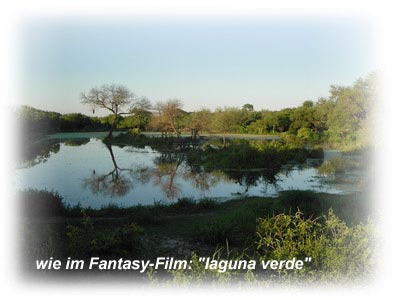
I follow it around several bends and corners (without any more “challenges”) and suddenly I find myself facing a most beautiful lagoon which could not have been arranged better for any fantasy film. The road leads halfway round it and less than 150 metres further on I reach a small white cottage with three dogs and for human beings. Herbert’s foreman Jorge and his wife Teresa and their children Joel and Jorge (junior) welcome me, they have already been waiting for us. I quickly get rid of my luggage and my jacket soaked with sweat and the (also nearly soaking wet) helmet. I tell them that I have to go back to help Ricarda. Meanwhile we have to worry about nightfall.
I ride to the small stream and walk back the muddy part of the way. Ricarda meets me – also walking. ”Is it still a long way?” are her only words. “No, no, and the road improves a lot and in addition you will see a most beautiful lagoon,” I try to calm her down. Then I stamp on to her motorbike and for a second time I struggle along the muddy road slipping as if it was covered with ice. At this moment I wish that in Argentine we had put on tyres for bad road conditions instead of tyres for normal roads.
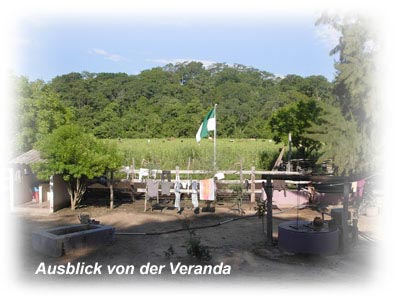
Exactly an hour has passed since the “friendly” military policeman who showed us the “right” (3 km short/long) way. Thoroughly exhausted, muddy, and dripping and smelly with sweat – but really relieved – we arrive together in the yard in front of the white cottage of Herbert’s finca. From now on things will improve – I am sure – and this comes true.
We spend
two wonderful, interesting and exciting weeks at
the finca, get to know many people, as Emma
(Herbert’s wife) and Herbert take us to the town
Yacuiba various times and introduce us to their friends (after two days
of sunshine the creek can be passed by car again). So
we get to know different customs and habits, at times at a birthday party,
or a christening ceremony, or an invitation to a “Guiso
de Fideo”-meal.
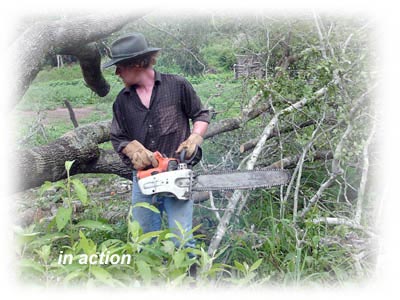
Of course we do not spend all the time at the finca in a huge hammock, or cool down in the former watering tank for cattle below the three-inch-shower (as Herbert calls the thick hose), or play with the parrot, or drink wine, or formally open a new dam, or for many other times repair the small blue tricycle, so that Joel can take his little brother for a ride, or let us bewitch by Emma’s art of cooking and the “Sopa de Maní" or, or, or …..
No, we try to help where our
hands are needed. For one day I struggle
with two power saws to clear away a thick tree, that
has come down during the last storm, and turn it into bio mass (as Herbert
calls it). By the way, Herbert had told his foreman Jorge
not to get rid of the tree, as “power saw specialists”
would come for a visit.
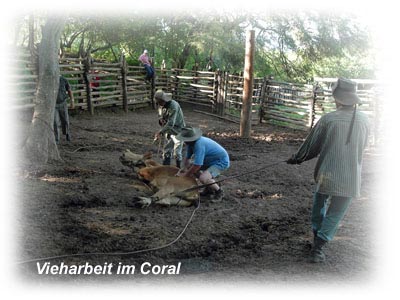
Together with Herbert, Emma, their daughter Demelza, their son Friederich and the two farm hands, Jorge and Freddy, we are busy for two days inoculating the nearly 200 cattle and branding and gelding the young cattle. We have to do a real job, several times we have to “long-fly” over the fence of the coral, which is two metres high, to save our lives from the cattle that turned wild.
One afternoon it is raining above all, and the loamy soil gets slippery, muddy, deep and heavy. Jorge and Freddy need more and more attempts to catch another animal, because the lassos get heavy with water and mud. But we hold out until in the end the intended number of cattle is done with.
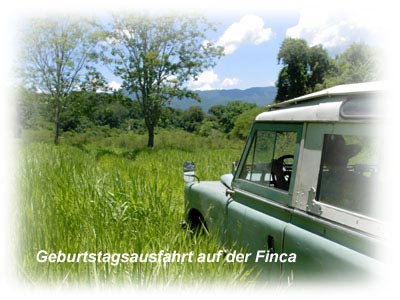
Herbert shows us around the finca a few times, either walking or on horseback (only here we have learnt to ride on horseback) and in a 40-year-old Jeep (my birthday trip). He explains the problem with the watercourses in this area, as here at the foot of the Andes watercourses have not yet found their final places. Depending on how much water there is the rivers flow here or there, take away much soil in places and deposit it in other places.
So Herbert is permanently busy
to get the main river of the finca under control
which means that he uses heavy equipment to build dams in different places.
Nevertheless he has held his ground during 23 years as the owner of the
finca. On the contrary he is still enthusiastic about
the (simple) life on a finca and about his ideas for
the future.
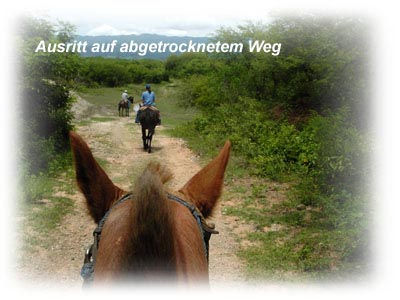

The two weeks come to an end, and we have found a possibility to get rid of some unnecessary luggage – at least for some time. As we are still near the Argentine border, we go back there for three hours. We send a 15 kg parcel containing thick biker boots and jackets as well as warm clothing for the winter to Buenos Aires by bus, for we plan to leave the continent from there later.
The day before we finally want to leave the finca, we have to go to Yacuiba again to refuel our motorbikes. But when I start my bike there is only a short-circuit! Nothing moves, not a thing, all lamps dark. “What is wrong now?” It is nearly half past seven and getting dark, so that I cannot see much. We push the motorbike into the workshop, but the 12 volt solar light does not help a lot. At any case I will have to wait until the next day, when daylight will make it possible to find out what is wrong. In the evening Jorge tells me that there use to be a lot of rats in the place where we leave the motorbikes. So I think a cable might be broken or something like that.
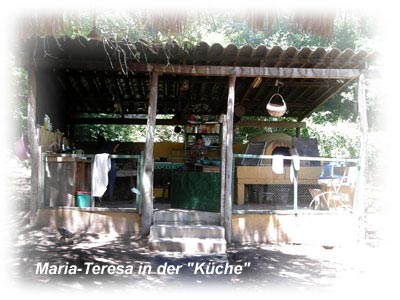
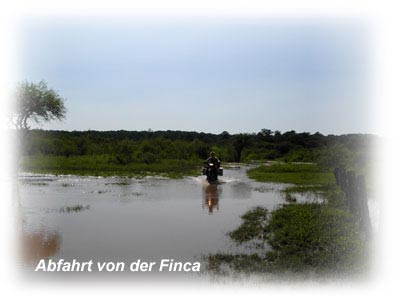
After having solved the problem and everything is put away again, Maria Teresa calls us for lunch. She has baked her delicious Sopaipillas for us again. After the meal we decide that we do not feel much like packing and leaving. It is damp and hot, temperatures at 38°C – so we stay another day. During the night this turns out to have been a bad decision.
It is raining cats
and dogs. The next morning I start to explore
the finca: The water in the rivulets and rivers
has gone up at least for 50cm, too much to go through by motorbike.
So we have to wait for another day. We hope that it will not rain
again during the night. Fortunately the next night remains
dry and the following day the water has gone down so
far, that we can leave the finca in shorts
and rubber boots and keep more or less
dry.
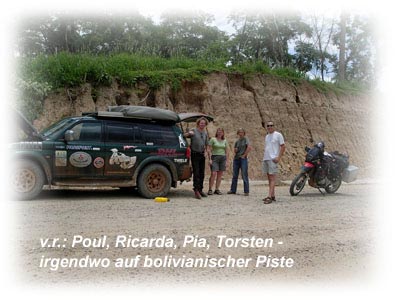
Two days of travelling later we start from Camiri early in the morning, for the asphalt road to Santa Cruz de la Sierra ends after 30 km, then there is a 150(!) km long site of road works – the Bolivian way: There are some 10 km in between completely done with asphalt and even traffic-line marking, followed by some 15 km that look as if road building has just begun and you cannot imagine you still are on the right way…
Somewhere in the middle of the construction chaos we meet two “old acquaintances”: Pia and Poul from Denmark, whom we met in the peninsula Valdez in Argentine weeks ago. They are sitting in their car at the roadside in the blazing sun. We join them. An hour later we have fixed the next date: Carnival in Rio! (Be sure not to miss that story….)
In the afternoon we finally
enter Santa Cruz, and we may again stay with our friends
Kurt and Txepi. We have intended to stay for three
or four days and again we spend two weeks with them, for Kurt has made
many plans for us.
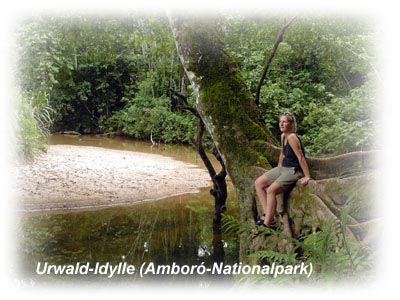
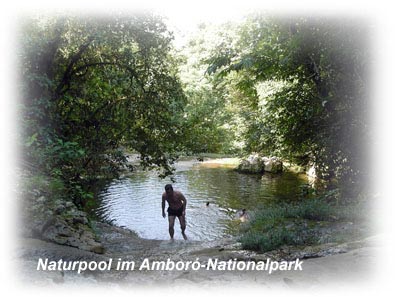
We slowly calm down. As it is nearly
dark, she has not been able to really identify the snake: Maybe poisonous,
or very poisonous, or only little poisonous…Afterwards Ricarda is
a little worried: “Only a short time ago we have
been swimming in this rivulet,” she says rather
disconcertedly. Kurt laughs and tries to calm her down:
“Finding a snake is a mere accident, I am sure
there will be no other.” To make
a long story short: 17 minutes later Kurt has no more socks
on his feet, two times more
we had to react to Txepi’s orders, and that always very rapidly.
They tell us that they have never before caught three snakes
in such a short time. There are more than 20 snakes in Txepi’s cage
at home now.
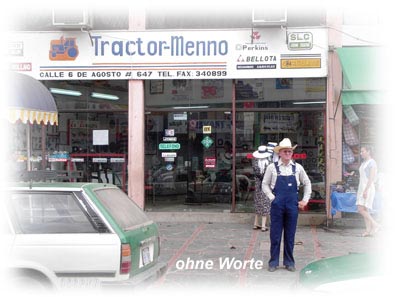
One morning Kurt takes us into town to see the Mennonite centre . (There are several Mennonite communities in Bolivia. In the south-eastern part of the country, the so-called Chiquetania, they live their lives like 200 years ago without electricity, television etc.)
The Mennonites meet in a certain quarter of Santa Cruz to sell the products of their farms like cheese. At the same time they buy goods and tools, that they cannot produce themselves. A huge amount of goods is being offered: From axes over devices for making cheese to scales for food. There are brand-new tools – but they were up to date 50 years ago. I feel to have stepped back into the world of my great-grandparents.
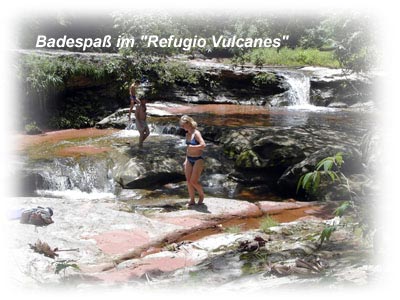
The next weekend Kurt prepares a Churrasco (barbeque) for us and invites some relatives whom we have already met more than a year ago when we first stayed in Santa Cruz. Again there is so much food that we can take enough with us on our trip the next day. We go to the “Refugio de los Volcanes” , situated at the south western edge of the Amboró National Park. For several hours we hike through the Refugio and see a lot of the Bolivian birds. But finally we end up – we are on a trip with Kurt - spending the afternoon in beautiful dreamlike natural pools and under their waterfalls.

At the station in Santa Cruz we make inquiries for possibilities and conditions of transport for our motorbikes, because we want to take the “rumble train” from Santa Cruz to Brazil. That is a nearly 700 km ride crossing the Chiquetania – but that will be another story..
The last night of our stay Kurt serves another special dinner. He has fried Isbies (small fish from Lake Titicaca) in a pan. Very delicious, and so it is hard again to say good-bye the next morning.